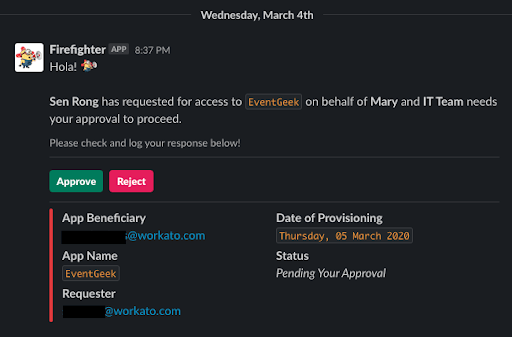The coronavirus, or COVID-19 (the respiratory disease it causes), is forcing organizations to rethink how they work. Many companies have implemented mandatory work from home policies, an unprecedented move that is causing both company leadership and IT to think about how they can enable a diverse and varied workforce to do their jobs from home.
In a survey of 100 global IT executives, respondents felt that the IT team (28%) was “leading the effort to plan for the remote workforce during this coronavirus pandemic,” followed by HR (18%), Other Company Execs (18%) and Operations (12%).
We’ve experienced the same burden of how to roll out a successful transition here at Workato. Our CEO, Vijay Tella, has offered the following guidelines for working from home during the outbreak:
- Be overly responsive (more than normal) to each other, on Slack, Zoom, Email, and text, so we can continue to deliver on what we’re working on. Make the extra effort to communicate and close the loop, including using things like the ✅ in Slack to acknowledge requests or calls to action.
- Managers: Start a Slack channel that is just for your team members (if you don’t have one already).
- Managers: Host a daily stand-up meeting with your team to sync on plans, open issues and such for the day. Then, at the end of the day, report back to the team on your Slack team channel. Keep in touch with team members on their work routine.
- Continue with your weekly meetings. If they were in-person, move them to Zoom or Google Hangouts and use your video. This will help us from feeling too detached from our teams and a great opportunity for our pets to make special appearances. 🙂
- Please make every effort to attend all-hands meetings and lunch and learn sessions.
- If there are specific situations that are not highlighted above, please post your questions and comments on the #covid-19 Slack channel.
We think these are great asks for any organization to consider, and realize technology is key in enabling these things to happen. Here are some of the tools we’re using and mandates we’re requesting during this remote work period.
Update Your Slack, Zoom, Google and Other Profiles to Include Your Full Name and Photo
Though a lot of us are practicing social distancing, now is the time get personal digitally. While your immediate colleagues may know what you look like, there’s a good chance some of your coworkers have never seen you before. You may also have meetings with customers, partners, and other external parties that would have otherwise been in person. Let these interactions still enable the participant to put a name to a face.
If you have Slack or Microsoft Teams, be sure to completely fill out your profile with your department, a brief description of what you do, as well as your work hours (and time zone) and the best number to reach you at. If someone is contacting you for the first time, seeing that information will inform them of the best times to reach you and what for.
Find Dedicated Time and Space in Your House to Do Your Work
Not everyone has home offices, but this would be the time to create one, if resources allow. Find a corner of your room or spot in your house that’s isolated from TVs, streaming devices, radios or anything else that could be distracting.
Manage Your Time in a More Public Way
To also give yourself the best chance of success, block time slots off on your calendar for work – that includes responding to emails, writing agendas, preparing for meetings, etc. – even if it’s for 30 minutes at a time. It can be very easy to lose track of progress, or forget you had to do something if you don’t set time to do it.
And don’t swipe away your reminders. Make sure you have to physically mark the item as completed once you’re finished – or that you reschedule them if time doesn’t allow. If you have a project management tool like Wrike or Airtable, all the better.
Create a ChatOps Culture for Your Business
While we use Slack at Workato, many teams utilize other apps like Microsoft Teams, Facebook Workplace, or Webex Teams to stay in touch. Now that your entire organization is working from home, these chat apps are more important than ever. Here are some creative ways we’ve internally put Slack and Workbot for Slack to work:
1. Submit IT Requests
As we transition to work from home, different team members may need to be provisioned with new apps. Our Firefighter Bot allows us to make IT requests and manage approval workflows through Slack without crowding our IT team’s inbox or logging into yet another platform to submit a ticket.
When one of our employees wants to submit a request, all they have to do is type in slash command `/itrequest` into Slack. Once a Business Technology/IT Manager assigns each ticket to a team member, they can immediately get to work and move the card through the different phases of development. The requester will receive notifications in Slack as the task progresses and, of course, once the task is completed.

If the request requires an approval, the manager will get an alert in Slack from the IT team asking for it. The manager can approve or reject with the click of a button, and the app gets provisioned!

2. Host Stand-Up Meetings
Our CEO asked us to host stand-up meetings daily, but it’s not always the best use of time to listen to a team of 12 go through their entire day. Instead, we use Stand-Up Bot.
Stand-up meetings – or short meetings for people to give brief updates on their work progress to their teams – are common practice in Agile Development, but are starting to be used across business for their ability to boost productivity, eliminate bottlenecks, clarify accountability, and reduce wasteful tasks in a matter of minutes.
If a manager wants to set up a stand-up meeting, they simply type in slash command `/standup` in their team’s Slack channel. The bot will then ask the manager a few questions: what time do you want the stand-up message to send, and what are the custom questions for your team? After setup, the bot will send a daily message to the channel automatically asking each team member to fill in their answers for that day. And that’s it! A quick stand-up meeting has been fully conducted inside of Slack.
Automation Enables Better Work
These are just some of the ways remote teams can use automation and SaaS tools to make each day during this transition easier than the last. Both now and in the long run, we think everyone should harness the power of these tools to improve employee experience. The future of work is no longer out there…it’s here, happening right now.
Please also look to the CDC and WHO for precautions to take during this time.
